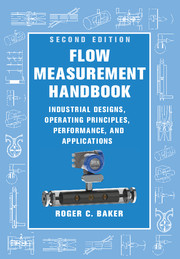Book contents
- Frontmatter
- Dedication
- Contents
- Preface
- Acknowledgements
- Nomenclature
- 1 Introduction
- 2 Fluid Mechanics Essentials
- 3 Specification, Selection and Audit
- 4 Calibration
- 5 Orifice Plate Meters
- 6 Venturi Meter and Standard Nozzles
- 7 Critical Flow Venturi Nozzle
- 8 Other Momentum-Sensing Meters
- 9 Positive Displacement Flowmeters
- 10 Turbine and Related Flowmeters
- 11 Vortex Shedding, Swirl and Fluidic Flowmeters
- 12 Electromagnetic Flowmeters
- 13 Magnetic Resonance Flowmeters
- 14 Ultrasonic Flowmeters
- 15 Acoustic and Sonar Flowmeters
- 16 Mass Flow Measurement Using Multiple Sensors for Single-Phase Flows
- 17 Multiphase Flowmeters 508
- 18 Thermal Flowmeters
- 19 Angular Momentum Devices
- 20 Coriolis Flowmeters
- 21 Probes for Local Velocity Measurement in Liquids and Gases
- 22 Verification and In Situ Methods for Checking Calibration
- 23 Remote Data Access Systems
- 24 Final Considerations
- References
- Main Index
- Flowmeter Index
- Flowmeter Application Index
3 - Specification, Selection and Audit
Published online by Cambridge University Press: 05 August 2016
- Frontmatter
- Dedication
- Contents
- Preface
- Acknowledgements
- Nomenclature
- 1 Introduction
- 2 Fluid Mechanics Essentials
- 3 Specification, Selection and Audit
- 4 Calibration
- 5 Orifice Plate Meters
- 6 Venturi Meter and Standard Nozzles
- 7 Critical Flow Venturi Nozzle
- 8 Other Momentum-Sensing Meters
- 9 Positive Displacement Flowmeters
- 10 Turbine and Related Flowmeters
- 11 Vortex Shedding, Swirl and Fluidic Flowmeters
- 12 Electromagnetic Flowmeters
- 13 Magnetic Resonance Flowmeters
- 14 Ultrasonic Flowmeters
- 15 Acoustic and Sonar Flowmeters
- 16 Mass Flow Measurement Using Multiple Sensors for Single-Phase Flows
- 17 Multiphase Flowmeters 508
- 18 Thermal Flowmeters
- 19 Angular Momentum Devices
- 20 Coriolis Flowmeters
- 21 Probes for Local Velocity Measurement in Liquids and Gases
- 22 Verification and In Situ Methods for Checking Calibration
- 23 Remote Data Access Systems
- 24 Final Considerations
- References
- Main Index
- Flowmeter Index
- Flowmeter Application Index
Summary
Introduction
The object of this chapter is to assist the reader in specifying a proposed flowmeter's operational requirements as fully as possible and hence to enable the reader to select the right flowmeter. The reason for wishing to select a flowmeter may be obvious: a flow rate to be measured. However, the reason in some cases may be less obvious. If you are a flowmeter manufacturer, or prospective manufacturer, you may wish to identify a type and design which would meet a particular market niche. If you are a member of an R&D team, you may be exploring measurement areas which are inadequately covered at present.
This chapter is little changed from Baker (2000), which developed earlier ideas (Baker 1989; Baker and Smith 1990), and I have benefitted from the ideas of others such as Endress+Hauser (1989; cf. 2006). In Baker and Smith (1990), we took a different line from Baker (1989), providing the means to specify the user's needs in as much detail as possible. We then provided a form for communication with the manufacturer.
Many people have attempted to provide a means of selecting a flowmeter. An expert system to assist in selection has seemed to me the way forward, but the on-line or CD selection methods, available from some manufacturers, may essentially be providing a satisfactory approach. Such data is likely to reflect the manufacturer's latest developments.
Specifying the Application
The major manufacturers appear to have developed their choice of flowmeter types to cover most of the commonest technologies. I suspect that this has the useful effect of ensuring that the most appropriate type will be utilised for a particular application.
On flow measurement workshops we have run over the years at Cranfield University, at Cambridge and at Endress+Hauser, we divided up into working groups for selecting flowmeters for particular applications. Almost invariably there was more than one meter suitable to a lesser or greater extent for each application. This will mean that more than one meter may be suitable for the job in hand, but the manufacturer may give an experienced view as to the best one.
I have, therefore, developed the theme of Baker and Smith (1990) in this chapter. We start with a form and discuss the implications of each item for user and manufacturer.
- Type
- Chapter
- Information
- Flow Measurement HandbookIndustrial Designs, Operating Principles, Performance, and Applications, pp. 52 - 66Publisher: Cambridge University PressPrint publication year: 2016



